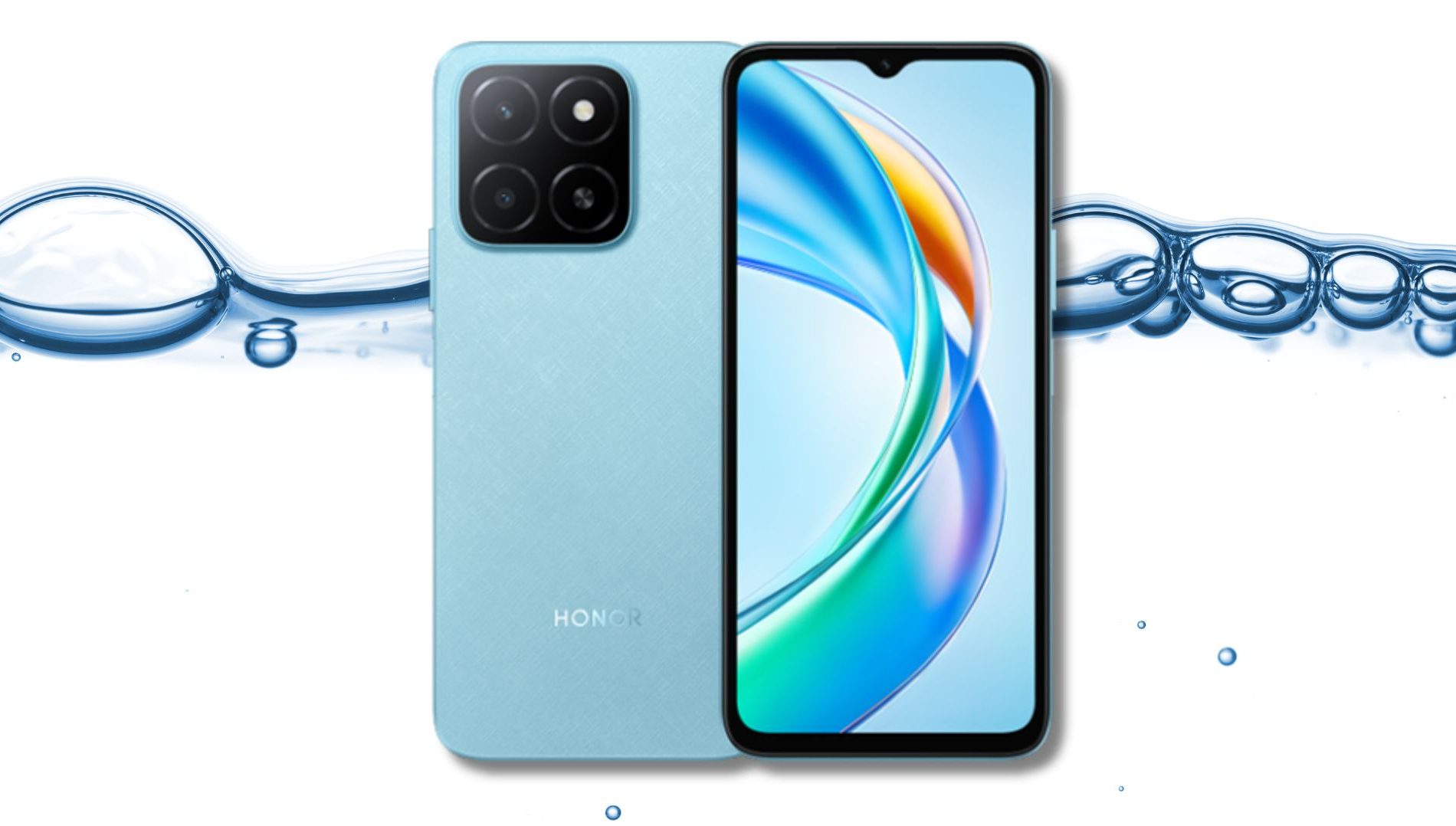The POCO F7 Pro is here, and it’s shaping up to be one of the most compelling flagship killers of the year.
Packed with a Snapdragon 8 Gen 3 chipset, a stunning 6.67-inch 2K AMOLED display, and a massive 6000mAh battery with 90W fast charging, POCO has pretty-much refined its formula for high-performance devices at a competitive price.
But does it deliver? Let’s get into it.

Design and Build
Right out of the box, the POCO F7 Pro gives off a nice impression when in-hand with its nice glass back and metal frame.
Speaking of the back, it’s a fancy-shmancy two-toned glass panel, glossy at the top and matte at the bottom with some POCO branding here as well.

We found it interesting to see the patterning with the rear camera module, I’m a big fan of it? Not necessarily, but I do like the fact that POCO’s experimenting here and there in terms of design.
The aluminum middle frame adds a nice touch to structural integrity, and ergonomics feel adequate for its tall dimensions.

At 206g and measuring 8.12mm thick, it’s slightly heavier than the competition it faces, but the weight is justified by the large battery.
It also gets an IP68 rating for protection against dust-sized particles and freshwater submersion of up to 1.5 meters for 30 minutes.

Found on the right is the volume rocker and power button, and below is the dual-nano SIM card tray, main microphone for calls, USB Type-C port for charging and data transfers, and one out of two STEREO speakers.
Its pair can be found in the slit of the top display bezel that doubles as the call earpiece.

All-in-all it’s a pretty standard no BS build, with some flare that is the rear panel design.
Display, Multimedia and Biometrics
For display, the POCO F7 Pro boasts a 6.67-inch 2K Flow AMOLED panel (3200 x 1440 resolution).

It offers a 120Hz refresh rate that pairs well with the tuned HyperOS UI animations and nice mobile gaming.
Color reproduction from the 2K display is vibrant, thanks to the wide color gamut support. And outdoor visibility is no slouch with the 3200 nits of peak brightness.

The panel also features 3840 Hz PWM dimming and TÜV Rheinland certifications for low blue light and flicker-free performance. When it came to streaming media on the phone, the POCO F7 Pro pretty much reminded me how much I missed those extra pixels.

I mean, over the years I’m sure most of us started agreeing that FHD on phone displays were good enough, because the screen’s themselves weren’t that big the first place, which is why when I upgraded from the Galaxy S10 to the S23, I lost some pixels!
So when something like the POCO F7 Pro with it’s 2K panel comes along, I just miss them so much!
Not to mention, the stereo speakers over here up their game with some Dolby Atmos to deliver an immersive audio experience, with a loud and balanced sound stage.

Meanwhile for biometrics, the F7 Pro features an ultrasonic in-display fingerprint sensor, which is pretty much the most secure kind of in-display fingerprint scanning tech out there. Compared to optical scanners, we can even unlock the device with slightly wet fingers.
And recognition has been superb, no issues here. There’s also optical face-unlocking options available, but I didn’t rely on it too much in my review.
Cameras

Moving over to cameras.
At the rear we get a main 50MP Light Image 800 sensor that features OIS, and is said to improve low-light performance.
It’s capable of capturing sharp, detailed images with good dynamic range. The colors are quite accurate out of the box too, even with HDR turned on. And even without using portrait mode, we can get some decent bokeh from the main camera as is.

Even without a zoom lens, the main camera takes good-enough photos even when digitally zooming. It’s workable even up to 5x zoom, as you can see in the sample photos.
Anything beyond that, we notice a drop in quality, and more of the AI postprocessing at work to smoothen things out.
The 8MP ultrawide camera is serviceable for wider shots, but it doesn’t offer the same level of detail as the main sensor. But if we just needed that extra field of view from time-to-time, it’s definitely good enough.
Meanwhile, the 20MP front-facing camera takes very decent selfies with AI enhancements too.
As for the video, the F7 Pro can record up to 8K@24 FPS using the main rear camera. And the quality is amazing considering the price point of this phone.
But take note that we can’t use the ultrawide or even zoom when shooting in 8k. Bumping it down to 4K solves that issue and can even save us some storage.
There is also EIS on-board in the form of the ShootSteady video setting, but we get limited to 1080p recording when in-use.
Honestly, we don’t really feel like we need it for general video recording, especially when we don’t wanna deal with the crop.
Other notable features for camera include 50MP mode, dual video recording, and slow motion to name a few. Interestingly there’s also Director Mode, which allows users to shoot in xiaomi or POCO LOG, which we plan to revisit in a dedicated video soon.
OS, Apps and UI
Running on Xiaomi HyperOS 2 based off Android 15 out of the box, the POCO F7 Pro feels really nice when navigating through the interface.

Animations are smooth and fluid. Holding the power-button down activates Google Gemini, holding the gesture navigation bar brings up Circle-to-Search.
— Standard 2025 Android things.
Even the dedicated gallery gets some useful AI photo editing features. From automatically enhancing photos to removing reflections, and even erasing unwanted things from the shot.

Take note that we do need a Xiaomi account to use some of these AI features.
Overall, the UI is smooth and responsive and everything is easy to find in the settings.
As usual, pre-installed apps remain a minor downside. Minor because, we can just uninstall most of them, and turn off notifications from annoying apps we can uninstall.

So overall, no major gripes here. Oh, and just like last year, we can expect the POCO F7 Pro to receive 3 major OS updates and 4 years of security patches.
Performance and Benchmarks
Under the hood, the POCO F7 Pro sports a Qualcomm Snapdragon 8 Gen 3, a 4nm chipset found in flagships from last year.
This results in a 32% CPU performance boost, 34% GPU improvement, and a staggering 98% AI performance increase compared to the POCO F6 Pro.

Our unit is configured with 16GB of LPDDR5X memory and 512GB of UFS 4.1 storage, we can also extend RAM with another 12GB with the memory extension setting.
In real world use, you’d expect the F7 Pro handle almost anything you throw at it. And just like that, it totally did!

We ran into no problems doing all our everyday tasks, from multitasking between several apps to running multiple apps at the same time, there virtually weren’t any slowdowns to take note of.
When it came to heavy-gaming like Genshin Impact, the phone ran it smoothly even with the graphic settings maxed out without any frame rate drops or lag. We also clocked in some Solo Leveling gameplay with again, no issues.

And thanks to the LiquidCool Technology 4.0 found in the phone, thermals are kept in check even during prolonged gaming sessions. But do keep in mind that the phone still warms up like almost any other.
Interestingly, the heat was evenly dissipated across the entire back panel compared to other phones that usually just have a hotspot.
Either way it wasn’t the biggest deal, and for more performance juice we can even put the phone in Ultimate Mode which provides slightly higher clock speeds.
Those of you interested in the numbers can check out our benchmark scores on screen.
| Chipset: | Qualcomm Snapdragon 8 Gen 3 |
| RAM | 16GB |
| Antutu v10 | 1,882,402 |
| Geekbench Single-Core | 2,176 |
| Geekbench Multi-Core | 6,534 |
| Geekbench OpenCL | 14,727 |
| Geekbench Vulkan | 16,375 |
| 3D Mark Wild Life | N/A |
| PCMark Work 3.0 | 16,191 |
| Antutu v10 STORAGE | 198,370 |
| Seq. Read | 3900.7 MB/s |
| Seq. Write | 3422.3 MB/s |

Battery Life
Powered by a 6000mAh battery, the POCO F7 Pro delivers pretty good battery life that can pretty much handle a day of regular use while having to charge before going to bed.
The included 90W HyperCharge brick can charge the battery up from 0 to 100% in just 37 minutes, making it one of the fastest-charging devices in its segment.

In our PCMark Work 3.0 Battery Test, the F7 Pro garnered a result of 15 hours and 59 minutes, this result was achieved while in the Balanced battery mode.
End-users stuck to their phone all day may want to consider utilizing Ultra and normal Battery Saver modes when tryna preserve as much battery as they can without needing to charge.
Connectivity

For connectivity the F7 Pro does not get e-Sim support but we do get 5G enabled here for both sides of the dual nano SIM card tray , as well as Wi-Fi 7, Bluetooth 5.4, NFC, and GPS.
Additionally, POCO did include an IR blaster here for using the phone as a smart remote, but instead of putting it at the top, its actually found in the rear camera module.
Conclusion

In conclusion, I’m happy to report that the POCO F7 Pro still deserves to be called a flagship killer and it definitely delivers.
Flagship-grade performance, a crispy high-refresh 2K display, great build quality and battery life, and even an ultrasonic in-display fingerprint scanner!
Samsung better wake up! Because Xiaomi and its POCO army are definitely stirring the pot.
So, if you’re looking for a device that excels in gaming, multimedia, and everyday performance without breaking the bank, the POCO F7 Pro might be the one for you.

What we LIKED:
- Powerful Snapdragon 8 Gen 3 performance
- Stunning QHD+ OLED display
- 90W fast charging
- HyperOS 2.0
What we Liked LESS:
- No telephoto sensor
POCO F7 Pro Specs:
6.67-inch 2K Flow AMOLED display
3200 x 1440 pixels, 120Hz, 526 ppi
3200 nits peak brightness
Corning Gorilla Glass 7i
Qualcomm Snapdragon 8 Gen 3
4nm, octa-core, Adreno 750 GPU
12GB LPDDR5X RAM
256GB, 512GB UFS 4.1 storage
50MP f/1.6 main, Light Fusion 800 sensor, OIS
8MP f/2.2 ultrawide
20MP selfie camera
Dual nano-SIM
5G, 4G LTE
Wi-Fi 7
Bluetooth 5.4
Dual-frequency GPS
USB Type-C
NFC
Under-display fingerprint sensor (ultrasonic), face unlock
IP68 dust and water resistance
Dual stereo speakers, IR blaster
Xiaomi HyperOS 2, Android 15
6000mAh battery
90W HyperCharge (wired)
160.26 x 74.95 x 8.12 mm
206g
Black, Silver, Blue (colorways)

 3 days ago
8
3 days ago
8





